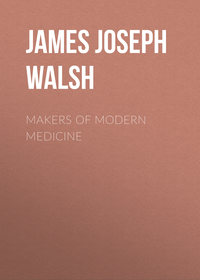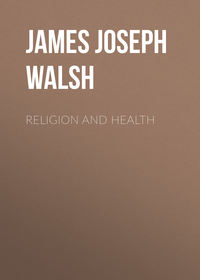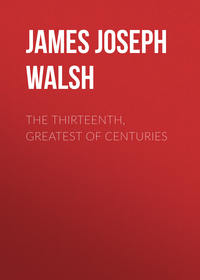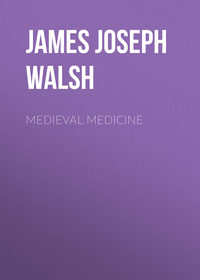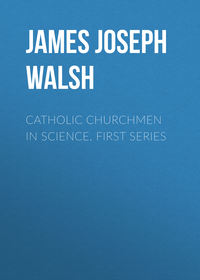 полная версия
полная версияThe Popes and Science
To most people it will be utterly uncomprehensible, however, that after all that they have heard about Church opposition to science and Papal discouragement of education as dangerous to faith, there should now be an absolute denial of the supposed grounds for the assertions in this matter. Most readers, even among educated people, will be very prone to think that their impressions in these matters cannot be entirely wrong, and that previous writers on the subject cannot have been either deceiving or deceived. In all that relates to the Roman Catholic Church, however, before the date of the so-called reformation, it is important to remember that there came into existence a definite body of Protestant tradition, the creation of the reformers who wished to blacken the memory of the Old Church as much as possible to justify their own apostasy, and who therefore spared no means to pervert the facts of history or to exaggerate the significance of historical details so as to produce this false impression. Subsequent generations were oftener deceived themselves than deceiving. They were sure that the Church was opposed to education and to science, and consequently it was not hard for them to read in certain incidents and documents a meaning quite other than their actual significance, because this added meaning agreed with their prejudices on these subjects.
Every advance in modern history, every modification of view that has been brought about by the critical historical method of recent times, has emphasized this point of view almost without exception. The distinguished philosophic and historical writer, the Comte de Maistre, in his Soirées of St. Petersburg about a century ago, declared that "History for the last three centuries (1500-1800) has been a conspiracy against the truth." Just about a century later the editors of the Cambridge Modern History, in the preface to the first volume of their monumental work, re-echoed the words of the Comte de Maistre almost literally in a pregnant paragraph which deserves to be in the note-book of everyone who is trying to get at the real truth of history. They said:
"Great additions have of late been made to our knowledge of the past; the long conspiracy against the revelation of truth has gradually given way, and competing historians all over the civilized world have been zealous to take advantage of the change. The printing of archives has kept pace with the admission of enquirers; and the total mass of new matter, which the last half-century has accumulated, amounts to many thousands of volumes. In view of changes and of gains such as these, it has become impossible for the historical writer of the present age to trust without reserve even to the most respected secondary authorities. The honest student finds himself continually deserted, retarded, misled by the classics of historical literature, and has to hew his own way through multitudinous transactions, periodicals and official publications in order to reach the truth.
"Ultimate history cannot be obtained in this generation; but, so far as documentary evidence is at command, conventional history can be discarded, and the point can be shown that has been reached on the road from one to the other."
The italics in this passage are ours, but the ideas they emphasize will serve to show how necessary it is for most of us to give up the supposed historical truth of the preceding generations and have an open mind for the newer ideas that are coming in as the result of the renewed consultation of original documents and primal sources of information. The present volume is written entirely with the idea of bringing out the facts of the relations of the Popes and the Church and the ecclesiastics, especially of the centuries before the reformation, to science and to scientific education. My own position as a professor of the history of medicine has necessarily made medical science very prominent in the book. This, however, far from being a disadvantage, is really an advantage, since the physical sciences of the medieval times gathered mainly around medicine, and it was chiefly physicians and medical students who devoted most time to them. After a detailed study of the history of medical science in the Middle Ages as well of its allied sciences, it becomes very clear that there was no trace of Papal or Church opposition to science as science, and, on the contrary, liberal patronage, abundant encouragement, and even pecuniary aid for the development of scientific education in every way.
What we have tried to give in this book, then, is the authoritative refutation of the supposed prohibition of the cultivation of certain departments of medical and allied sciences by the Popes, and sufficient information to enable students and teachers of science to realize that the ordinarily accepted notions with regard to opposition to science in the Middle Ages are founded on nothing more substantial than sublime ignorance of the facts of the history of science at that time. There was no bull against anatomy or dissection; no bull against chemistry; the Popes were the patrons of the great medical scientists and surgeons; the Papal Medical School was one of the best in the world and was sedulously fostered; the great scientists of the Middle Ages were clergymen, and many of them when they died were declared saints by the Church. The opposite impression is entirely a deduction from false premises with regard to the supposed attitude of the Church and churchmen. We shall furnish abundant authorities of the first rank and of value as absolute as there can be in present day history as to these questions. The consultation of these will furnish further material for those who desire to have real knowledge of the history of science in a magnificently original and greatly fruitful period.
THE SUPPOSED PAPAL PROHIBITION OF DISSECTION
There is a very general impression that the Roman Catholic Church was, during the Middle Ages, opposed to the practice of dissection, and that various ecclesiastical regulations and even Papal decrees were issued which prohibited, or at least limited to a very great degree, this necessary adjunct of medical teaching. These ecclesiastical censures are supposed to be in force, to some extent at least, even at the present time. The persuasion as to the minatory attitude of the Church in regard to dissection is so widespread among even supposedly well-educated professional men, that, as we have said in the introductory chapter, when there was question some time ago of opening a medical school in New York City under Catholic auspices as a department of Fordham University, a number of more than ordinarily intelligent physicians asked: What would be done about the study of anatomy, since in the circumstances suggested dissection would not be allowed? This false impression has been produced by writers in the history of science who have emphasized very strenuously the supposed opposition of the Church to science, and as these writers had a certain prestige as scholars their works have been widely read and their assertions have been unquestioned, because it would naturally be presumed that they would not make them without thorough investigation of such important questions. Professional men are not to blame if they have taken such statements seriously, even though they are absolutely without foundation. That statements of this kind should have been made by men of distinction in educational circles and should have passed current so long, is only additional evidence of an intolerant spirit in those who least suspect it in themselves and are most ready to deprecate intolerance in others.
Take a single example. Most of what is said as to the opposition of the Church to medicine during the Middle Ages in A History of the Warfare of Science with Theology in Christendom, by Andrew D. White (Appleton's, New York), is founded on a supposed Papal prohibition of anatomy and on a subsequent equally supposed Papal prohibition of chemistry. These two documents are emphasized so much, that most readers cannot but conclude that, even without further evidence, these are quite enough to prove the contention with regard to the unfortunate opposition of the Church to medical science. Without these two presumably solid pillars of actual Papal documents, what is said with regard to the Church and its relations to medical science in the Middle Ages amounts to very little. Much is made of the existence of superstitions in medicine as characteristic of the Middle Ages and as encouraged by clergymen, but medical superstitions of many kinds continue to have their hold on even the intelligent classes down to the present day in spite of the progress of education, and in countries where the Church has very little influence over the people. Dr. White quotes with great confidence and absolute assurance a Papal decree issued in the year 1300 by Pope Boniface VIII., which forbade the mutilation of the human body and consequently hampered all possibility of progress in anatomy for several important centuries in the history of modern science. Indeed, this supposed Papal prohibition of dissection is definitely stated to have precluded all opportunity for the proper acquisition of anatomical knowledge until the first half of the sixteenth century, when the Golden Age of modern anatomy set in. This date being coincident with the spread of the movement known as the Protestant Reformation, many people at once conclude that somehow the liberality of spirit that then came into the world, and is supposed at least to have put an end to all intolerance, must have been the active factor in this development of anatomy, and that, as Dr. White has indeed declared, it was only because the Church was forced from her position of opposition that anatomical investigation was allowed.
Since so serious an accusation is founded on a definite Papal document, it cannot but be a matter of surprise that those who have cited it so confidently as forbidding anatomy, and especially dissection, have never given the full text of the document. It is practically impossible for the ordinary reader, or even for the serious student of the history of medicine, to obtain a copy of this decree unless he has special library facilities at his command and the help of those who are familiar with this class of documents. Many references have been made to this prohibition by Pope Boniface VIII., but no one has thought it worth while to give, even in a footnote, the text of it. The reason for this is easy to understand as soon as one reads the actual text. It has nothing to say at all with regard to dissection. It has absolutely no reference to the cutting up of the human body for teaching purposes. Its purpose is very plain, and is stated so that there can be no possible misapprehension of its meaning. Here we have an excellent illustration of what the editors of the Cambridge Modern History declared to be the breaking up of the long conspiracy against the truth by the consultation of original documents.
Through the kindness of the Rev. D. A. Corbett, of the Seminary of St. Charles Borromeo, Overbrook, Pa., I have been able to secure a copy of Pope Boniface's decree, and this at once disposes of the assertion that dissection was forbidden or anatomy in any way hampered by it. Father Corbett writes:
"The Bull De Sepulturis of Boniface VIII. is not found in the Collectio Bullarum of Coquelines, nor is it incorporated in the Liber Sextus Decretalium Divi Bonifacii Papae VIII., though it is from here that it is quoted in the Histoire Litteraire de la France (as referred to by President White). It appears in an appendix to this sixth book among the Extravagantes, a term that is used to signify that the documents contained under it were issued at a time somewhat apart from the period this special book of decretals was supposed to cover. The Liber Sextus was published in 1298. This 'Bull De Sepulturis' was not issued until 1300. It is to be found in the third book of the Extravagantes, Chapter I."
Even a glance at the title would seem to be sufficient to show that this document did not refer even distantly to dissection, and this makes it all the harder to understand the misapprehension that ensued in the matter, if the document was quoted in good faith, for usually the compression necessary in the title is the source of such errors. The full text of the bull only confirms the absolute absence of any suggestion of forbidding dissection or discouraging the study of anatomy.
"Title–Concerning Burials.[Footnote 2] Boniface VIII. Persons cutting up the bodies of the dead, barbarously boiling them, in order that the bones, being separated from the flesh, may be carried for burial into their own countries, are by the very act excommunicated.
[Footnote 2: See Latin text in full in appendix.]
"As there exists a certain abuse, which is characterized by the most abominable savagery, but which nevertheless some of the faithful have stupidly adopted. We, prompted by motives of humanity, have decreed that all further mangling of the human body, the very mention of which fills the soul with horror, should be henceforth abolished.
"The custom referred to is observed with regard to those who happen to be in any way distinguished by birth or position, who, when dying in foreign lands, have expressed a desire to be buried in their own country. The custom consists of disemboweling and dismembering the corpse, or chopping it into pieces and then boiling it so as to remove the flesh before sending the bones home to be buried–all from a distorted respect for the dead. Now, this is not only abominable in the sight of God, but extremely revolting under every human aspect. Wishing, therefore, as the duty of our office demands, to provide a remedy for this abuse, by which the custom, which is such an abomination, so inhuman and so impious, may be eradicated and no longer be practiced by anyone, We, by our apostolic authority, decree and ordain that no matter of what position or family or dignity they may be, no matter in what cities or lands or places in which the worship of the Catholic faith flourishes, the practice of this or any similar abuse with regard to the bodies of the dead should cease forever, no longer be observed, and that the hands of the faithful should not be stained by such barbarities.
"And in order that the bodies of the dead should not be thus impiously and barbarously treated and then transported to the places in which, while alive, they had selected to be buried, let them be given sepulture for the time either in the city or the camp or in the place where they have died, or in some neighboring place, so that, when finally their bodies have been reduced to ashes or otherwise, they may be brought to the place where they wish to be buried and there be interred. And, if the executor or executrix of the aforesaid defunct, or those of his household, or anyone else of whatever order, condition, state or grade he may be, even if he should be clothed with episcopal dignity, should presume to attempt anything against the tenor of this our statute and ordination, by inhumanly and barbarously treating the bodies of the dead, as we have described, let him know that by the very fact he incurs the sentence of excommunication, from which he cannot obtain absolution (unless at the moment of death), except from the Holy See. And besides, the body that has been thus barbarously treated shall be left without Christian burial. Let no one, therefore, etc. (Here follows the usual formula of condemnation for the violation of the prescriptions of a decree.) Given at the Lateran Palace, on the twelfth of the calends of March, in the sixth year of our pontificate."
The reason for the bull is very well known. During the crusades, numbers of the nobility who died at a distance from their homes in infidel countries were prepared for transportation and burial in their own lands by dismemberment and boiling. The remains of Louis IX., of France, and a number of his relatives who perished on the ill-fated crusade in Egypt in 1270, are said to have been brought back to France in this fashion. The body of the famous German Emperor, Frederick Barbarossa, who was drowned in the river Saleph near Jerusalem, was also treated thus in order that the remains might be transported to Germany without serious decomposition being allowed to disturb the ceremonials of subsequent obsequies. Such examples were very likely to be imitated by many. The custom, as can be appreciated from these instances from different nations, was becoming so widespread as to constitute a serious source of danger to health, and might easily have furnished occasion for the conveyance of disease. It is almost needless to say to our generation that it was eminently unhygienic. Any modern authority in sanitation would at once declare against it, and the custom would be put an end to without more ado. There can be no doubt at all then that Pope Boniface VIII. accomplished good, not evil, by the publication of this bull. So anyone with modern views as to the danger of disease from the foolish custom which it abolished would at once have declared, and yet, by a perversion of its signification, it came to be connected with a supposed prohibition of dissection. For this misunderstanding Pope Boniface VIII. has had to suffer all sorts of reproaches and the Church has been branded as opposed to anatomy by historians(!)
Is it possible, however, that this bull was misinterpreted so as to forbid dissection, or at least certain forms of anatomical preparation which were useful for the study and teaching of anatomy? That is what Dr. White asserts. He shows, moreover, in his History of the Warfare of Science with Theology, that he knew that the document in question was perfectly inoffensive as regards any prohibition of dissection in itself, but insists that by a misinterpretation, easy to understand as he considers, because of the supposed opposition of ecclesiastics to medical science, it did actually prevent anatomical development. President White says: "As to the decretal of Pope Boniface VIII., the usual statement is that it forbade all dissections. While it was undoubtedly construed universally to prohibit dissection for anatomical purposes, its declared intent was as stated in the text; that it was constantly construed against anatomical investigations cannot for a moment be denied."
If a misinterpretation were subsequently made, surely Pope Boniface VIII. must not be held responsible for it; yet in spite of the fact that Dr. White shows that he knew very well that this bull did not forbid the practice of dissection, he does not hesitate to use over and over again expressions which would imply that some formal decision against dissection itself had been made, though this is the only Papal document he refers to. He even goes so far as to say that "anatomical investigation was made a sin against the Holy Ghost." He frequently repeats that for three centuries after the issuance of this bull the development of anatomy was delayed and hampered, and insists that only that Vesalius at great personal risk broke through this Church opposition, modern anatomy would never have developed. He proceeds constantly on the theory that it was always this bull that was in fault, though he confesses that if so, it was by a misunderstanding; and the only fault he can find to attribute to the Pope is a lack of infallibility, as he calls it, because he was not able to foresee that his bull would be so misunderstood.
I suppose we are to understand from this that Dr. White considers that he knows the meaning of the word infallibility. It is not a hard word to understand if one wishes to understand it. The meaning that he gives it in this passage is so entirely different from its accepted meaning among Catholics, that any schoolboy in any of our parochial schools would tell him that the word was never used by Catholics in the sense in which he here employs it. It is so misunderstood popularly outside of the Church, and this Dr. White doubtless knew very well. When a man uses a term in medicine in a different sense to that which is ordinarily accepted, we consider him ignorant; but when he deliberately uses it in another sense for his own purposes because of a false significance attached to it in the popular mind, we have a special name for him.
The whole matter, however, resolves itself into the simple question, "Was dissection prevented and anatomical investigation hampered after the issuance of the bull?" This is entirely a question of fact. The history of anatomy will show whether dissection ceased or not at this time. Now if those who so confidently make assertions in this matter had ever gone to a genuine history of anatomy, they would have learned at once that, far from this being the time when dissection ceased, the year 1300 is almost exactly the date for which we have the first definite evidence of the making of dissections and the gradual development of anatomical investigation by this means in connection with the Italian universities. This is such a curious coincidence that I always call it to the attention of medical students in lecturing on this subject.
The first dissection of which we have definite record, Roth tells us in his life of Vesalius, was a so-called private anatomy or dissection made for medico-legal purposes. Its date is the year 1302, within two years after the bull. A nobleman had died and there was a suspicion that he had been poisoned. The judge ordered that an autopsy be made in order to determine this question. Unfortunately we do not know what the decision of the doctors in the case was. We know only that the case was referred to them. Now it seems very clear that if this had not been a common practice before, the court would not have adopted this measure, apparently as a matter of judicial routine, as seems to have been the case in this instance. Had it been the first time that it was done instead of having the record of the transaction preserved only by chance, any mention of it at all would have appeared so striking to the narrator, that he would have been careful to tell the whole story, and especially the decision reached in the matter.
After this, evidence of dissection accumulates rapidly. During the second decade of the century Mondino, the first writer on anatomy, was working at Bologna. We have the records of his having made some dissections in connection with his university teaching there, and eventually he published a text-book on dissection which became the guide for dissectors for the next two centuries. Within five years after this we have a story of students being haled to court for body-snatching for anatomical purposes, and about this time there was, according to Rashdall in his History of the Universities, a statute of the University of Bologna which required the teacher in anatomy to dissect a body, if the students brought it to him. More than ten years earlier than this, that is, within ten years after the supposed Papal prohibition, there are records of dissections having been made at Venice in public, for the benefit of the doctors of the city, at the expense of the municipal treasury. During the first half of this century money was allowed at Bologna for wine, to be given to those who attended the public dissections, and if we recall the state in which the bodies must have been at a time when the use of preservatives was unknown, we can well understand the need for it. All this shows, as I have said, that the date of Boniface's bull (1300), far from representing the eclipse of anatomy, actually fixes the date of the dawn of modern practical anatomical study.
The most interesting question in this whole discussion is as to how much dissection Mondino actually did during the second decade of the fourteenth century. His book became the manual of dissection that was in practically every dissector's hands for several centuries after. Probably no book of its kind has ever been more used, and none maintained its place as the standard work in this department for so long. No less than 25 printed editions of it appeared altogether. It would seem to be utterly improbable that the author of a text-book of this kind could have made only a few dissections. There are a number of historians who have claimed, nevertheless, that at most he did not dissect more than three or four bodies. This is all that we have absolute evidence for, that is to say, only these dissections are recorded. It is easy to understand, however, that a professor of anatomy might make even hundreds of dissections, and yet have something to say only about a very few which happened to present some special peculiarities. The absence of further records may readily be accounted for also in other ways. The art of printing was not yet invented; paper had only just been discovered and was extremely expensive, and many factors conspired to destroy any records that may have been made.





